A Review on Two-Phase Volumetric Expanders and Their Applications
Abstract
1. Introduction
2. General Principles of the Two-Phase Volumetric Expanders
2.1. Pressure-Volume Diagram of Two-Phase Volumetric Expanders
- -
- Suction (1–2);
- -
- Expansion (2–3);
- -
- Free exhaust (3–4);
- -
- Forced exhaust (4–5’);
- -
- Recompression (5’–1’);
- -
- Pressure restoration (1’–1).
2.2. Performance Indicators of Two-Phase Volumetric Expanders
2.3. Flash Evaporation Fundamentals in Volumetric Two-Phase Expanders
2.4. Impact of Two-Phase Flow on Performances of Volumetric Expanders
3. Two-Phase Volumetric Expanders Applications
4. Two-Phase Scroll Expander
4.1. Working Principle of Two-Phase Scroll Expander
4.2. Literature Review of Two-Phase Scroll Expander
5. Two-Phase Twin Screw Expander
5.1. Working Principle of Two-Phase Twin Screw Expander
5.2. Literature Review of Two-Phase Twin Screw Expander
6. Two-Phase Vane Expander
6.1. Working Principle of Two-Phase Vane Expander
6.2. Literature Review of Two-Phase Vane Expander
7. Two-Phase Piston Expander
7.1. Working Principle of Two-Phase Piston Expander
7.2. Literature Review of Two-Phase Piston Expander
| Article, Year | Type | Study | Use | Fluid | V [cm3] | BVR [-] | pin [MPa] | Tin [°C] | pout [MPa] | N [rpm] | [kg/h] | P [kW] | ηis [-] | ηad [-] | ηm [-] | ηov [-] | ηvol [-] | FF [-] |
|---|---|---|---|---|---|---|---|---|---|---|---|---|---|---|---|---|---|---|
| [20] 2015 | F | E | R | water | 80–120 | 0.229 | 0.80–0.95 | |||||||||||
| [21] 2017 | F | Nc | R | R245fa | 1.26 | 100 | ||||||||||||
| [23] 2019 | RE | Nc | R | 100 | 200–1500 | 0.1–0.7 | 0.20–0.70 | |||||||||||
| [72] 2004 | RO | E | HP | CO2 | 7.17–7.34 | 31.6–33.5 | 2.67–2.81 | 600–2200 | 166–186 | 0.075–0.325 | 0.12–0.30 | |||||||
| [73] 2005 | F | E | HP | CO2 | 100 | 50 | 0.65–0.70 | 0.94 | ||||||||||
| [74,75] 2005 | RE | Nc, E | HP | CO2 | 2 × 13.26 | 6.05–7.25 | 26.0–31.4 | 2.92–2.76 | 114–120 | 9.7–13.5 | 0.036 | 0.11 | ||||||
| [76] 2006 | RO | Nc | HP | CO2 | 0.43–1.29 | 9 | 35 | 3.48 | ||||||||||
| [77] 2009 | RO | Nc, E | HP | CO2 | 7.70–8.20 | 33.5–35 | 3.97 | 750–2500 | 230.4–334.8 | 0.23–0.58 | ||||||||
| [78] 2010 | RO | Nc, E | HP | CO2 | 7.66 | 33.2 | 3.65 | 500–1900 | 0.435 | 0.25–0.45 | ||||||||
| [77] 2016 | F | Nc | PP | water | 0.1 | 100 | 0.0043 | 200–1500 | 0.1–0.8 | 0.40–0.70 | ||||||||
| [79] 2021 | RE | Nc, E | PP | Water Methanol | 381.7 | 21.0 | 1.72–3 | 102–104 | 0.11 | 250–1800 | 0.10–0.50 | 0.5–2.4 | ||||||
| [82] 2006 | S | E | HP | CO2 | 10 | 4 | 600–1800 | 0.28–0.44 | ||||||||||
| [83] 2005 | S | E | HP | CO2 | 9.4 | 3.4 | 2400–5400 | 0.65 | 0.59 | 0.98 | ||||||||
| [84] 2008 | RO | Nc, E | HP | CO2 | 0.45–0.58 | |||||||||||||
| [85] 2014 | RE | E | HP | CO2 | 4 × 0.096 | 1.0 | 8.5 | 26 | 3.2 | 180–400 | 3.6–7.5 | 0.003–0.005 | 0.5–0.6 | 0.3–0.4 | 0.8–0.9 | |||
| [86] 2017 | RA | Nc, E | HP | R134a | 102 | 1.01–1.69 | 40–60 | 0.35–0.56 | 400–500 |
8. Discussion
8.1. Considerations about the Literature Analysis
8.2. Comparison of the Two-Phase Devices
9. Conclusions
- -
- Flash expansion in a variable chamber volume needs to be further analyzed by numerical and experimental studies because it affects the operation of a two-phase device. In detail, the thermal disequilibrium between the vapor and liquid phases seems crucial because it penalizes the efficiency of the machines. As a result, the two-phase fluid must consist of the vapor phase containing fine liquid particles uniformly dispersed to improve the efficiency of the expander. The literature suggested that this aspect deserves further numerical and experimental investigations;
- -
- To the best of the authors’ knowledge, two-phase volumetric machines operating with a fixed pressure ratio allow for the changing of their SVFR for the same BVR and timing. As a result, the expansion can be complete or incomplete in the same device for the same pressure ratio, thus, resulting in a different isentropic efficiency. Consequently, some experimental or numerical analysis might be developed to confirm or rebut this conjecture;
- -
- Improving two-phase volumetric machines requires optimization of the shape of valves and ports to reduce the pressure drop and reduce leaks and friction losses. In detail, the passage of the fluid through the valves causes flashing effects;
- -
- Scroll and twin-screw expanders exhibit comparable volumetric and isentropic efficiency in which the maximum values of the latter are between 0.7 and 0.8. Scroll devices are employed for a few up to a dozen of kilowatt, while twin screw systems cover higher power output. Nonetheless, twin screw machines seem to be the most suitable for commercial applications because of their better compatibility with the liquid phase;
- -
- Vane expanders represent other machines tested as two-phase expanders in a power range below 1 kW, but most reach an isentropic efficiency within 0.15–0.62 and exhibit difficulty reducing friction and leaks;
- -
- Piston machines provide a broader range for isentropic efficiency because they are available in various kinematic architectures that result in different performances. Although some authors suggest that the liquid phase involves some issues in piston expanders, the literature has proposed them as machines suitable for transcritical CO2 vapor compression refrigeration cycles. Reciprocating piston systems exhibit an isentropic efficiency from 0.10–0.70 depending on the operating conditions. This range diminishes for rolling and swinging piston systems whose most of their isentropic efficiencies fall between 0.30 to 0.60. Nonetheless, other studies aim to propose the free piston expander as a two-phase machine suitable for ORC applications because its isentropic efficiency falls between 0.65–0.70, at least in the expansion of single-phase flow. Consequently, an investigation of a free piston machine operating in the two-phase region may be developed to assess the performance of this system.
Author Contributions
Funding
Institutional Review Board Statement
Informed Consent Statement
Data Availability Statement
Conflicts of Interest
Nomenclature
| Abbreviations | |
| E | Experimental |
| F | Free |
| Nc | Numerical |
| Pt | Patent |
| R | Research |
| RE | Reciprocating |
| RO | Rolling |
| RA | Radial |
| S | Swing |
| Acronyms | |
| BVR | Built-in volume ratio [-] |
| CHP | Combined heating and power |
| FF | Filling Factor [-] |
| HP Heat pump | |
| PP | Power production |
| SVFR | Specific volumetric fluid ratio [-] |
| Greek symbols | |
| η | Efficiency [-] |
| Symbols | |
| Mass flow rate [kg/s], [kg/h] | |
| N | Rotating speed [rpm], [rad/s] |
| p | Pressure [Pa], [MPa], [bar] |
| P | Power [W], [kW] |
| T | Temperature [°C], [K] |
| V | Displacement [cm3], [mm3] |
| Subscripts | |
| in | Inlet |
| is | Isentropic |
| m | Mechanical |
| ov | Overall |
| vol | Volumetric |
References
- Briola, S.; Di Marco, P.; Gabbrielli, R. Two-Phase Fluid Expanders—A Review. In Proceedings of the XXX Heat Transfer Conference of Union Italian Thermo-Fluid Dynamic (UIT), Bologna, Italy, 24–27 June 2012. [Google Scholar]
- Briola, S.; Di Marco, P.; Gabbrielli, R. Two-Phase Fluid Compressors—A Review. In Proceedings of the XXXI Heat Transfer Conference of Union Italian Thermo-Fluid Dynamic (UIT), Como, Italy, 25–27 June 2013. [Google Scholar]
- Heidelck, R.; Kruse, H. Expansion machines for Carbon Dioxide based on modified reciprocating machines. In Proceedings of the Final Proceedings of the 4th-IIR Gustav-Lorentzen Conference on Natural Working Fluids at Purdue, West Lafayette, IN, USA, 25–28 July 2000. [Google Scholar]
- Li, D.; Baek, A.E.; Groll, P.B. Thermodynamic analysis of vortex tube and work out expansion devices for the transcritical carbon dioxide cycle. In Proceedings of the Final Proceedings of the 4th-IIR Gustav-Lorentzen Conference on Natural Working Fluids at Purdue, West Lafayette, IN, USA, 25–28 July 2000. [Google Scholar]
- Heyl, P.; Quack, H. Transcritical CO2 cycle with expander/compressor. In Proceedings of the Final Proceedings of the 4th-IIR Gustav-Lorentzen Conference on Natural Working Fluids at Purdue, West Lafayette, IN, USA, 25–28 July 2000. [Google Scholar]
- Kruse, H.; Rüssmann, H.; Martin, E.; Jakobs, R. Positive Displacement Carbon Dioxide Expansion Machines-Changes and Limitations. In Proceedings of the International Compressor Engineering Conference, West Lafayette, IN, USA, 17–20 July 2006; p. 1766. [Google Scholar]
- Zhang, Z.; Ma, Y.; Li, M.; Zhao, L. Recent advances of energy recovery expanders in the transcritical CO2 refrigeration cycle. HVACR Res. 2013, 19, 376–384. [Google Scholar]
- Dumont, O.; Parthoens, A.; Dickes, R.; Lemort, V. Experimental investigation and optimal performance assessment of four volumetric expanders (scroll, screw, piston and roots) tested in a small-scale organic Rankine cycle system. Energy 2018, 165, 1119–1127. [Google Scholar] [CrossRef]
- Daniarta, S.; Kolasinski, P. A preliminary study of two phase volumetric expanders and their application in ORC systems. In Proceedings of the 6th International Seminar on ORC Power Systems, Munich, Germany, 11–13 October 2021. [Google Scholar]
- Lemort, V.; Legros, A. Positive displacement expanders for Organic Rankine Cycle systems. In Organic Rankine Cycle (ORC) Power Systems; Elsevier: Amsterdam, The Netherlands, 2017. [Google Scholar]
- Emhardt, S.; Tian, G.; Chew, J. A review of scroll expander geometries and their performances. Appl. Therm. Eng. 2018, 141, 1020–1034. [Google Scholar] [CrossRef]
- Imran, M.; Usman, M.; Park, B.S.; Lee, D.H. Volumetric expanders for low grade andwaste heat recovery applications. Renew. Sustain. Energy Rev. 2016, 57, 1090–1109. [Google Scholar] [CrossRef]
- Antonelli, M.; Baccioli, A.; Francesconi, M.; Desideri, U.; Martorano, L. Operating maps of a rotary engine used as an expander for micro-generation with various working fluids. Appl. Energy 2014, 113, 742–750. [Google Scholar] [CrossRef]
- Antonelli, M.; Baccioli, A.; Francesconi, M.; Martorano, L. Experimental and numerical analysis of the valve timing effects on the performances of a small volumetric rotary expansion machine. Energy Procedia 2014, 45, 1077–1086. [Google Scholar] [CrossRef]
- Francesconi, M.; Dori, E.; Antonelli, M. Analysis of Balje diagrams for a Wankel expander prototype. Appl. Energy 2019, 238, 775–785. [Google Scholar] [CrossRef]
- Antonelli, M.; Baccioli, A.; Francesconi, M.; Martorano, L. Numerical and experimental analysis of the intake and exhaust valves of a rotary expansion machine for micro generation. Energy Procedia 2015, 81, 461–471. [Google Scholar] [CrossRef]
- Francesconi, M.; Pasini, G.; Sani, L.; Antonelli, M. Experimental investigation of a commercial screw compressor as an expander with compressed air. In Proceedings of the 5th International Seminar on ORC Power Systems, Athens, Greece, 9–11 September 2019. [Google Scholar]
- Quoilin, S.; Van Den Broek, M.; Declaye, S.; Dewallef, P.; Lemort, V. Techno-economic survey of Organic Rankine Cycle (ORC) systems. Renew. Sustain. Energy Rev. 2013, 22, 168–186. [Google Scholar] [CrossRef]
- Richter, L.; Rendlova, Z.; Planicka, S.; Seeger, J.; Taschek, M.; Volf, M.; Pelikan, M.; Linhart, V. Experimental and numerical analysis of an oil-flooded air screw expander. In Proceedings of the 20th Conference on Power System Engineering, Pilsen, Czech Republic, 7–9 September 2021; MATEC Web Conf.. Volume 345. [Google Scholar]
- Kanno, H.; Shikazono, N. Experimental and modeling study on adiabatic two-phase expansion in a cylinder. Int. J. Heat Mass Transf. 2015, 86, 755–763. [Google Scholar] [CrossRef]
- Lecompte, S.; Van der Broek, M.; De Paepe, M. Initial Design of an Optical-Access Piston Expansion Chamber for Wet-Expansion. Energy Procedia 2017, 129, 307–314. [Google Scholar] [CrossRef][Green Version]
- Van Heule, X.; De Paepe, M.; Lecompte, S. Two-phase volumetric expanders: A review of the state-of-art. Energies 2022, 15, 4991. [Google Scholar] [CrossRef]
- Wang, Q.; Wu, W.; He, Z.; Ziviani, D. Analysis of the intake process and its influence on the performance of a two-phase reciprocating expander. Appl. Therm. Eng. 2019, 160, 113943. [Google Scholar] [CrossRef]
- Smith, I.K.; Stosic, N.; Kovacevic, A. Power Recovery from Low Grade Heat by Means of Screw Expanders; Elsevier: Amsterdam, The Netherlands, 2014. [Google Scholar]
- Smith, K. Development of the trilateral flash cycle system—Part 1: Fundamental aspects. Proc. Inst. Mech. Eng. Part A J. Power Energy 1993, 208, 179–194. [Google Scholar] [CrossRef]
- Meng, D.; Liu, Q.; Ji, Z. Effects of two-phase expander on the thermoeconomics of organics double-flash cycles for geothermal power generation. Energy Part D 2022, 239, 122346. [Google Scholar] [CrossRef]
- Briola, S.; Di Marco, P.; Gabbrielli, R. Thermodynamic sensitivity analysis of a novel trigeneration thermodynamic cycle with two-phase expanders and two-phase compressors. Energy 2017, 127, 335–350. [Google Scholar] [CrossRef]
- Briola, S.; Gabbrielli, R.; Fino, A.; Bischi, A.; Di Marco, P. Working fluid selection and extensive sensitivity analysis for the thermodynamic optimization of a novel trigeneration thermodynamic cycle with two-phase expanders and compressors. Energy 2019, 179, 709–726. [Google Scholar] [CrossRef]
- Briola, S.; Gabbrielli, R.; Baccioli, A.; Fino, A.; Bischi, A. Thermo-economic analysis of a novel trigeneration cycle enabled by two-phase machines. Energy 2021, 227, 120453. [Google Scholar] [CrossRef]
- Tamura, I.; Taniguchi, H.; Sasaki, H.; Yoshida, R.; Sekiguchi, I.; Yokogawa, M. An analytical investigation of high-temperature heat pump system with screw compressor and screw expander for power recovery. Energy Convers. Manag. 1997, 38, 10–13. [Google Scholar] [CrossRef]
- Weitzer, M.; Muller, D.; Karl, J. Two-phase expansion processes in heat pump—ORC systems (Carnot batteries) with volumetric machines for enhanced off-design efficiency. Renew. Energy 2022, 199, 720–732. [Google Scholar] [CrossRef]
- Daniarta, S.; Kolasinski, P.; Imre, A.R. A Preliminary design and modeling analysis of two-phase volumetric expanders for a novel reversible Organic Rankine-Based Cycle for Carnot battery technology. Appl. Sci. 2022, 12, 3557. [Google Scholar] [CrossRef]
- Fukuta, M.; Yanagisawa, T.; Kosuda, O.; Ogi, Y. Performance of scroll expander for CO2 refrigeration cycle. In Proceedings of the International Compressor Engineering Conference, West Lafayette, IN, USA, 17–20 July 2006. [Google Scholar]
- Hiwata, A.; Ikeda, A.; Morimoto, T.; Kosuda, O.; Matsui, M. Axial and radial force control for CO2 scroll expander. In Proceedings of the International Compressor Engineering Conference, West Lafayette, IN, USA, 14–17 July 2008. [Google Scholar]
- Kohsokabe, H.; Koyama, M.; Tojo, K.; Matsunaga, M.; Nakayama, S. Performance characteristics of scroll expander for CO2 refrigeration cycles. In Proceedings of the International Compressor Engineering Conference, West Lafayette, IN, USA, 14–17 July 2008. [Google Scholar]
- Huff, H.J.; Radermacher, R. CO2 Compressor-Expander Analysis; Report prepared for Air-conditioning and Refrigeration Technology Institute, Under ARTI 21-CR Program Contract Number 611-10060; Air-Conditioning and Refrigeration Technology Institute: Arlington, VA, USA, 2003. [Google Scholar]
- Huff, H.J.; Lindsay, D.; Radermacher, R. Positive displacement compressor and expander simulation. In Proceedings of the International Compressor Engineering Conference, West Lafayette, IN, USA, 16–19 July 2002. [Google Scholar]
- Westphalen, D.; Dieckmann, J. Scroll expander for carbon dioxide air conditioning cycles. In Proceedings of the International Compressor Engineering Conference, West Lafayette, IN, USA, 12–15 July 2004. [Google Scholar]
- Westphalen, D.; Dieckmann, J. Scroll expander for carbon dioxide cycle. In Proceedings of the International Compressor Engineering Conference, West Lafayette, IN, USA, 17–20 July 2006. [Google Scholar]
- Kohsokabe, H.; Funakoshi, F.; Tojo, K.; Nakayama, S.; Kohno, K.; Kurashige, K. Operating characteristics of CO2 chiller cycles with expander-compressor unit. In Proceedings of the 8th IIR Gustav Lorentzen Conference on Natural Working Fluids, Copenhagen, Denmark, 7–10 September 2008. [Google Scholar]
- Kim, H.J.; Ahn, J.M.; Cho, S.O.; Cho, K.R. Numerical simulation on scroll expander–compressor unit for CO2 transcritical cycles. Appl. Therm. Eng. 2008, 28, 1654–1661. [Google Scholar] [CrossRef]
- Nagata, H.; Kakuda, M.; Sekiya, S.; Shimoji, M.; Koda, T. Development of a scroll expander for the CO2 refrigeration cycle. In Proceedings of the International Compressor Engineering Conference, West Lafayette, IN, USA, 12–15 July 2010. [Google Scholar]
- Kim, H.J.; Ahn, J.M.; Park, I.; Rha, P.C. Scroll expander for power generation from a low-grade steam source. Proc. IMechE Part A J. Power Energy 2007, 221, 705–711. [Google Scholar] [CrossRef]
- Mayer, K. Research, Development and Demonstration of Micro-CHP System for Residential Applications; DOE/NT/42216; ECR Int.: Utica, NY, USA, 2010. [Google Scholar]
- Muhammad, I.; Muhammad, U. Positive Displacement Machines—Modern Design Innovations and Tools, Chapter 11—Mathematical Modelling for Positive Dis-Placement Expanders; Elsevier: Amsterdam, The Netherlands, 2019. [Google Scholar]
- Smith, I.K.; Stosic, N.; Kovacevic, A. Power Recovery from Low Cost Two-Phase Expanders; Geothermal Research Council: San Diego, CA, USA, 2001. [Google Scholar]
- Sprankle, R.S. Electrical Power Generating Systems. U.S. Patent 3,751,673, 7 August 1973. [Google Scholar]
- Smith, I.K.; Stosic, N. Development of the Trilateral Flash Cycle System Part 3: The design of high efficiency two phase screw expanders. Proc. Inst. Mech. Eng. Part A J. Power Energy 1996, 210, 75–93. [Google Scholar] [CrossRef]
- Smith, I.K.; Stosic, N. Screw expanders increase output and decrease the cost of geothermal binary power plant systems. In Proceedings of the Geothermal Research Council Annual Meeting, Reno, NV, USA, 25–28 September 2005. [Google Scholar]
- Smith, I.K.; Stosic, N.; Kovacevic, A. Cost effective small scale ORC systems for power recovery from low enthalpy resources. In Proceedings of the Geothermal Research Council Annual Meeting, Reno, NV, USA, 30 September–3 October 2007. [Google Scholar]
- Read, M.; Stosic, N.; Smith, I.K. Optimization of screw expanders for power recovery from low-grade heat sources. Energy Technol. Policy 2014, 1, 131–142. [Google Scholar] [CrossRef]
- Vasuthevan, H.; Brummer, A. Thermodynamic modelling of screw expander in a Trilateral Flash cycle. In Proceedings of the International Compressor Engineering Conference, West Lafayette, IN, USA, 11–14 July 2016. [Google Scholar]
- Nikolov, A.; Brummer, A. Impact of different clearance heights on the operation of a water-flooded twin-screw expander—Experimental investigations based on indicator diagrams. IOP Conf. Ser. Mater. Sci. Eng. 2018, 425, 12008. [Google Scholar] [CrossRef]
- Bianchi, G.; Marchionni, M.; Miller, J.; Tassou, S.A. Modelling and off-design performance optimisation of a trilateral flash cycle system using two-phase twin-screw expanders with variable built-in volume ratio. Appl. Therm. Eng. 2020, 179, 115671. [Google Scholar] [CrossRef]
- Smith, I.K.; Stosic, N.; Aldis, C.A.; Kovacevic, A. Twin screw two-phase expanders in large chiller units. In Proceedings of the IMechE, International Conference on Compressors and Their Systems, London, UK, 30 September 1999. [Google Scholar]
- Smith, I.K.; Stosic, N. The expressor: An efficiency boost to vapour compression systems by power recovery from the throttling process. In Proceedings of the ASME International Mechanical Engineering Congress and Exposition, San Francisco, CA, USA, 12–17 November 1995. [Google Scholar]
- Brasz, J.J.; Shitsla, V.; Stosic, N.; Smith, I.K. Development of a twin-screw expressor as a throttle valve replacement for water-cooled chillers. In Proceedings of the International Compressor Engineering Conference, West Lafayette, IN, USA, 25–28 July 2000. [Google Scholar]
- Stosic, N.; Smith, I.K.; Kovacevic, A. A twin screw combined compressor and expander for CO2 refrigeration systems. In Proceedings of the International Compressor Engineering Conference, West Lafayette, IN, USA, 16–19 July 2002. [Google Scholar]
- Vodicka, V.; Novotny, V.; Mascuch, J.; Kolovratnik, M. Impact of major leakages on characteristics of a rotary vane expander for ORC. Energy Procedia 2017, 129, 387–394. [Google Scholar] [CrossRef]
- Yang, B.; Sun, S.; Peng, X.; Guo, B.; Xing, Z. Modeling and experimental investigation on the internal leakage in a CO2 rotary vane expander. In Proceedings of the International Compressor Engineering Conference, West Lafayette, IN, USA, 14–17 July 2008. [Google Scholar]
- Yang, B.; Peng, X.; Sun, S.; Guo, B.; Xing, Z. Study of a rotary vane expander for the transcritical CO2 cycle—Part I: Experimental investigation. HVACR Res. 2009, 15, 4. [Google Scholar] [CrossRef]
- Yang, B.; Peng, X.; He, Z.; Guo, B.; Xing, Z. Experimental investigation on the internal working process of a CO2 rotary vane expander. Appl. Therm. Eng. 2009, 29, 2289–2296. [Google Scholar] [CrossRef]
- Yang, B.; Peng, X.; Sun, S.; Guo, B.; Xing, Z. A study of the vane dynamics in a rotary vane expander for the transcritical CO2 refrigeration cycle. Proc. Inst. Mech. Eng. Part A J. Power Energy 2009, 223, 429–440. [Google Scholar] [CrossRef]
- Fukuta, M.; Higasiyama, M.; Yanagisawa, T.; Ogi, Y. Observation of CO2 transcritical expansion process. In Proceedings of the International Compressor Engineering Conference, West Lafayette, IN, USA, 14–17 July 2008. [Google Scholar]
- Jia, X.; Zhang, B.; Pu, L.; Guo, B.; Peng, X. Improved rotary vane expander for transcritical CO2 cycle by introducing high-pressure gas into the vane slots. Int. J. Refrig. 2011, 34, 732–741. [Google Scholar] [CrossRef]
- Mahmoud, A.M.; Sherif, S.A.; Lear, W.E. Analysis of rotary-vane two-phase refrigeration expanders: Geometric and thermodynamic modeling. In Proceedings of the 45th Aerospace Sciences Meeting and Exhibit, Reno, NV, USA, 8–11 January 2007. [Google Scholar]
- Mahmoud, A.M.; Sherif, S.A.; Lear, W.E. Development and testing of a rotary-vane two-phase refrigerating expander. In Proceedings of the ASME 2009 International Mechanical Engineering Congress & Exposition, Lake Buena Vista, FL, USA, 13–19 November 2009. [Google Scholar]
- Wang, M.; Zhao, Y.; Cao, F.; Bu, G.; Wang, Z. Simulation study on a novel vane-type expander with internal two-stage expansion process for R-410A refrigeration system. Int. J. Refrig. 2012, 35, 757–771. [Google Scholar] [CrossRef]
- Kim, H.J.; Kim, W.Y.; Ahn, J.M.; Cho, S.O. Numerical study on the performance improvement of a rotary vane expander for a CO2 heat pump cycle. Int. J. Air-Cond. Refrig. 2011, 19, 311–319. [Google Scholar] [CrossRef]
- Burugupally, S.P.; Weiss, L. Design and performance of a miniature free piston expander. Energy 2019, 170, 611–618. [Google Scholar] [CrossRef]
- Li, G.; Zhanh, H.; Yang, F.; Song, S.; Chang, Y.; Yu, F.; Wang, J.; Yao, B. Preliminary Development of a Free Piston Expander-Linear Generator for Small-Scale Organic Rankine Cycle (ORC) Waste Heat Recovery System. Energies 2016, 9, 300. [Google Scholar] [CrossRef]
- Li, M.; Ma, Y.; Guan, H.; Li, L. Development and Experimental Study of CO2 Expander in CO2 Supercritical Refrigeration Cycles. Int. J. Green Energy 2004, 1, 88–99. [Google Scholar] [CrossRef]
- Nickl, J.; Will, G.; Quack, H.; Kraus, W.E. Integration of a three stage expander into a CO2 refrigeration system. Int. J. Refrig. 2005, 28, 1219–1224. [Google Scholar] [CrossRef]
- Baek, J.S.; Groll, E.A.; Lawless, P.B. Piston-cylinder work producing expansion machine in a transcritical carbon dioxide cycle. Part I: Experimental investigation. Int. J. Refrig. 2005, 28, 141–151. [Google Scholar] [CrossRef]
- Baek, J.S.; Groll, E.A.; Lawless, P.B. Piston-cylinder work producing expansion machine in a transcritical carbon dioxide cycle. Part II: Theoretical model. Int. J. Refrig. 2005, 28, 141–151. [Google Scholar] [CrossRef]
- Yang, J.; Zhang, L.; Shi, J.Y. Development and Performance Analysis of a Two Cylinder Rolling Piston Expander for Transcritical CO2 System; Purdue ePubs; Purdue University: West Lafayette, IN, USA, 2006. [Google Scholar]
- Li, M.; Ma, Y.; Tian, H. A rolling piston-type two phase expander in the transcritical CO2 cycle. HVACR Res. 2009, 15, 729–741. [Google Scholar] [CrossRef]
- Tian, H.; Ma, Y.; Li, M.; Wang, W. Study on expansion recovery in CO2 trans-critical cycle. Energy Convers. Manag. 2010, 51, 2516–2522. [Google Scholar] [CrossRef]
- Rijpkema, J.; Thantla, S.; Fridh, J.; Andersson, S.; Munch, K. Experimental investigation and modeling of a reciprocating piston expander for waste heat recovery from a truck engine. Appl. Therm. Eng. 2021, 186, 116425. [Google Scholar] [CrossRef]
- Available online: https://www.greencarcongress.com/2015/06/20150618-libertine.html (accessed on 22 May 2022).
- Available online: https://www.libertine.co.uk/libertine-brunel-reach-milestone-free-piston-orc-demonstration-project/ (accessed on 22 May 2022).
- Guan, H.; Ma, Y.; Li, M. Some design features of CO2 swing piston expander. Appl. Therm. Eng. 2006, 26, 237–243. [Google Scholar]
- Sakitani, K.; Moriwaki, M.; Okamoto, M.; Kumakura, E.; Okamoto, T. Development of two-phase flow expander for CO2 heat pumps and air-conditioners. In Proceedings of the 2008 Short Course on 12th International Refrigeration and Air-Conditioning Conference at Purdue, West Lafayette, IN, USA, 14–17 July 2008. [Google Scholar]
- Matsui, M.; Wada, M.; Ogata, T.; Hasegawa, H. Development of High Efficiency Technology of Two Stage Rotary Expander for CO2 Refrigerant; Purdue ePubs; Purdue University: West Lafayette, IN, USA, 2008. [Google Scholar]
- Fukuta, M.; Anzai, F.; Motozawa, M.; Terawaki, H.; Yanagisawa, T. Performance of radial piston type reciprocating expander for CO2 refrigeration cycle. Int. J. Refrig. 2014, 42, 48–56. [Google Scholar] [CrossRef]
- Galoppi, G.; Secchi, R.; Ferrari, L.; Ferrara, G.; Karellas, S.; Fiaschi, D. Radial piston expander as a throttling valve in a heat pump: Focus on the 2-phase expansion. Int. J. Refrig. 2017, 82, 237–282. [Google Scholar] [CrossRef]
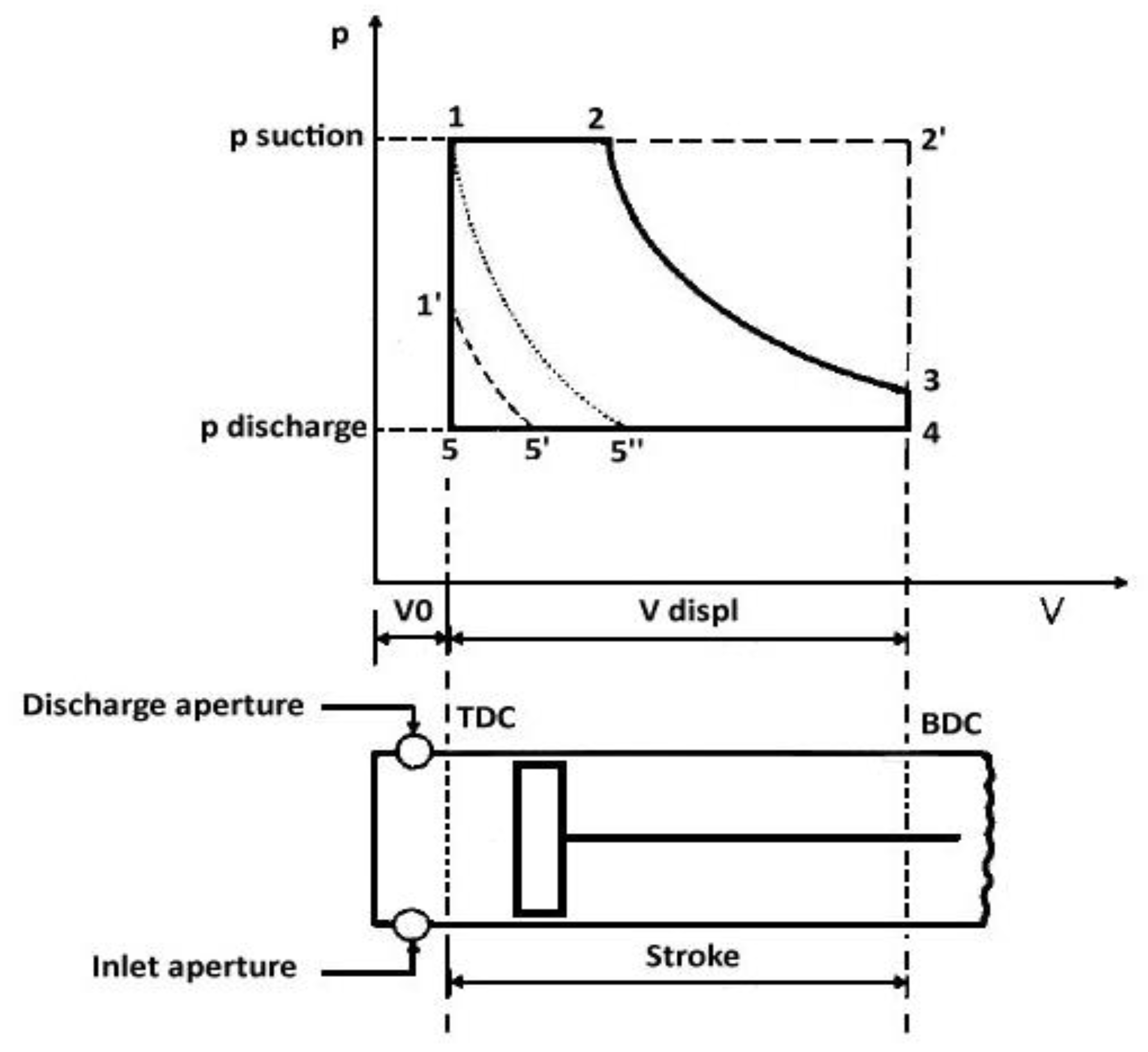
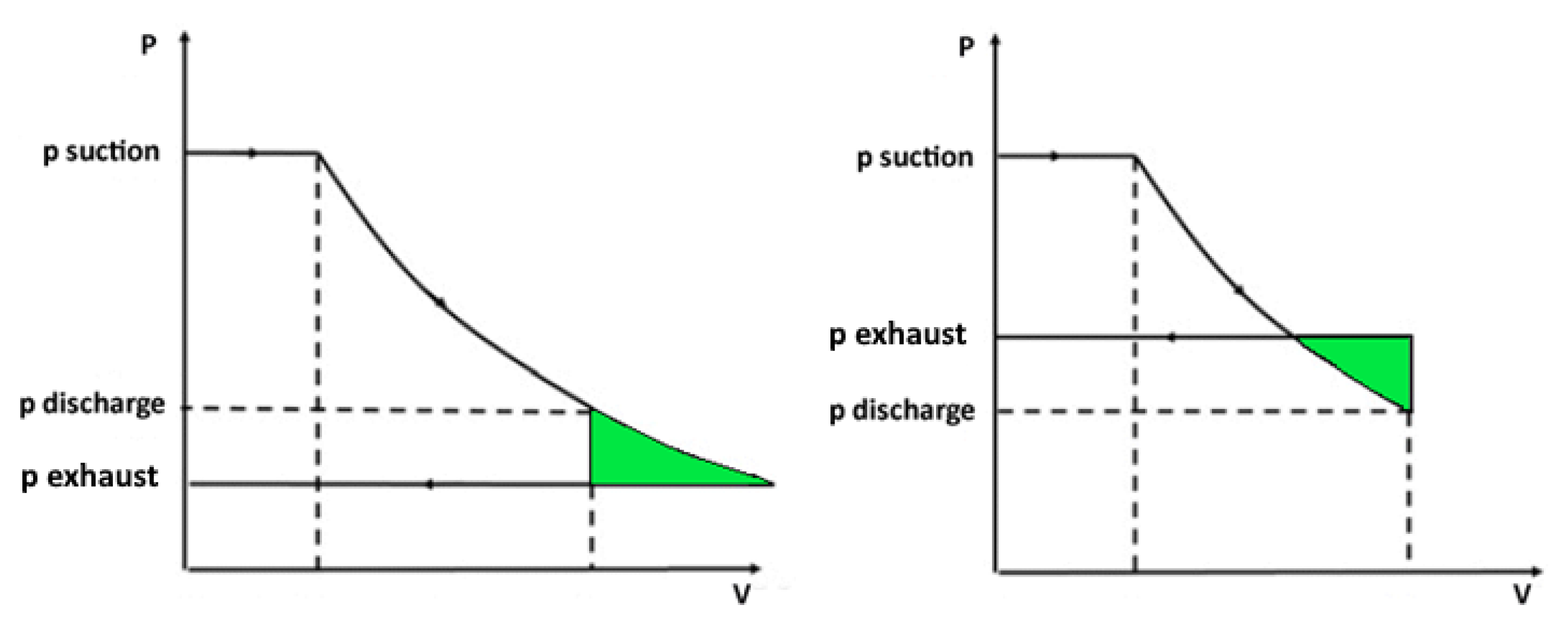

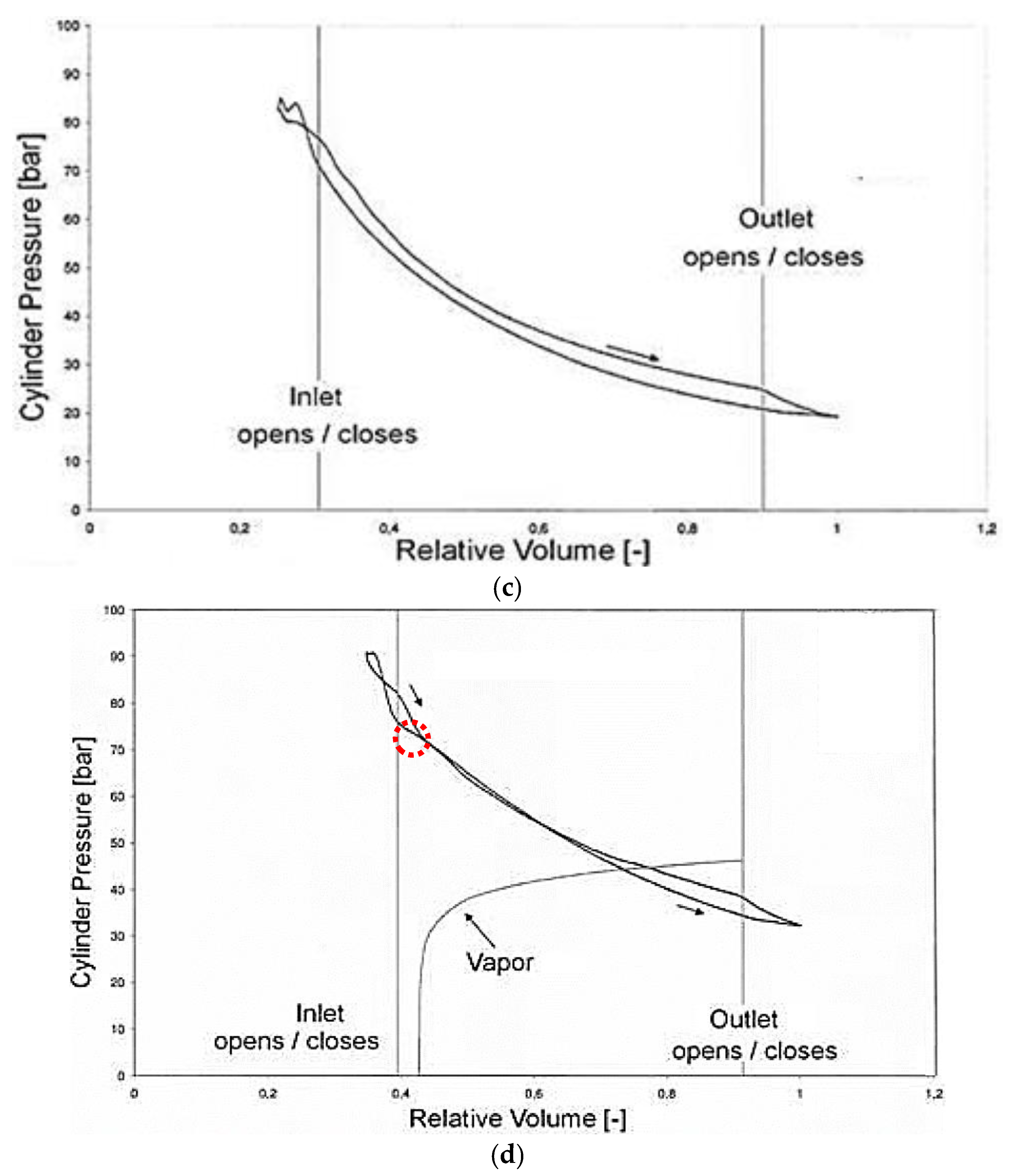
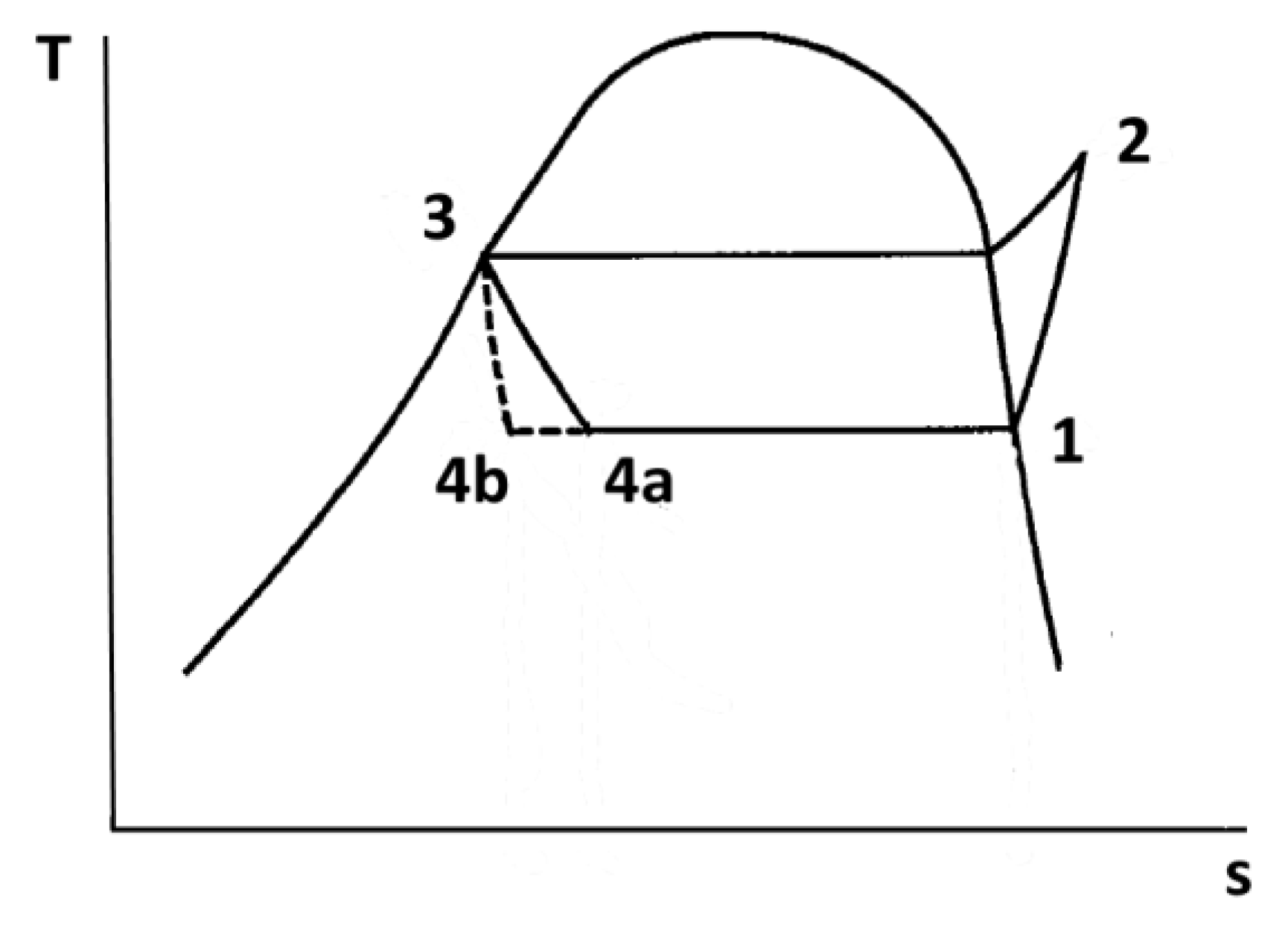
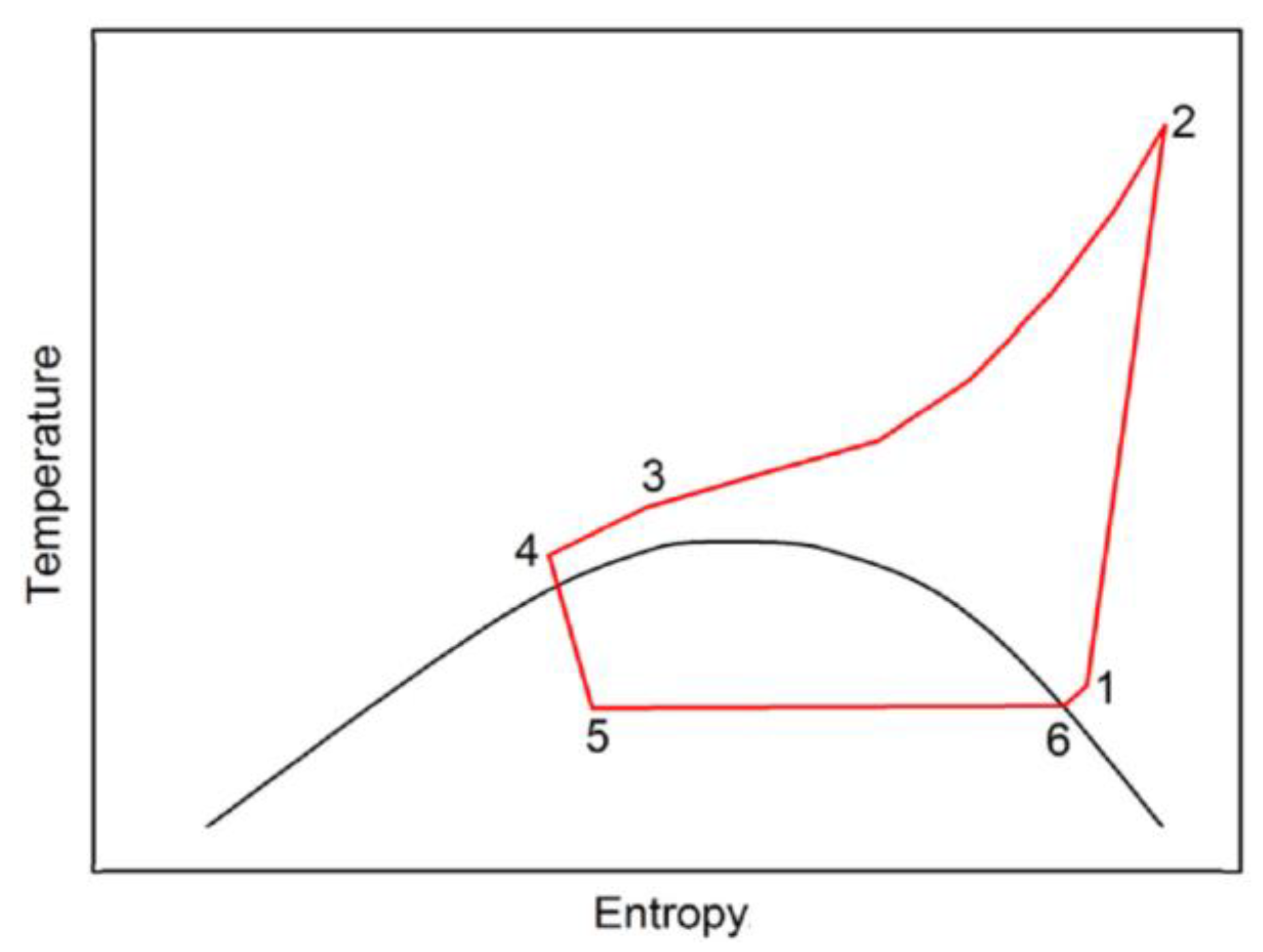
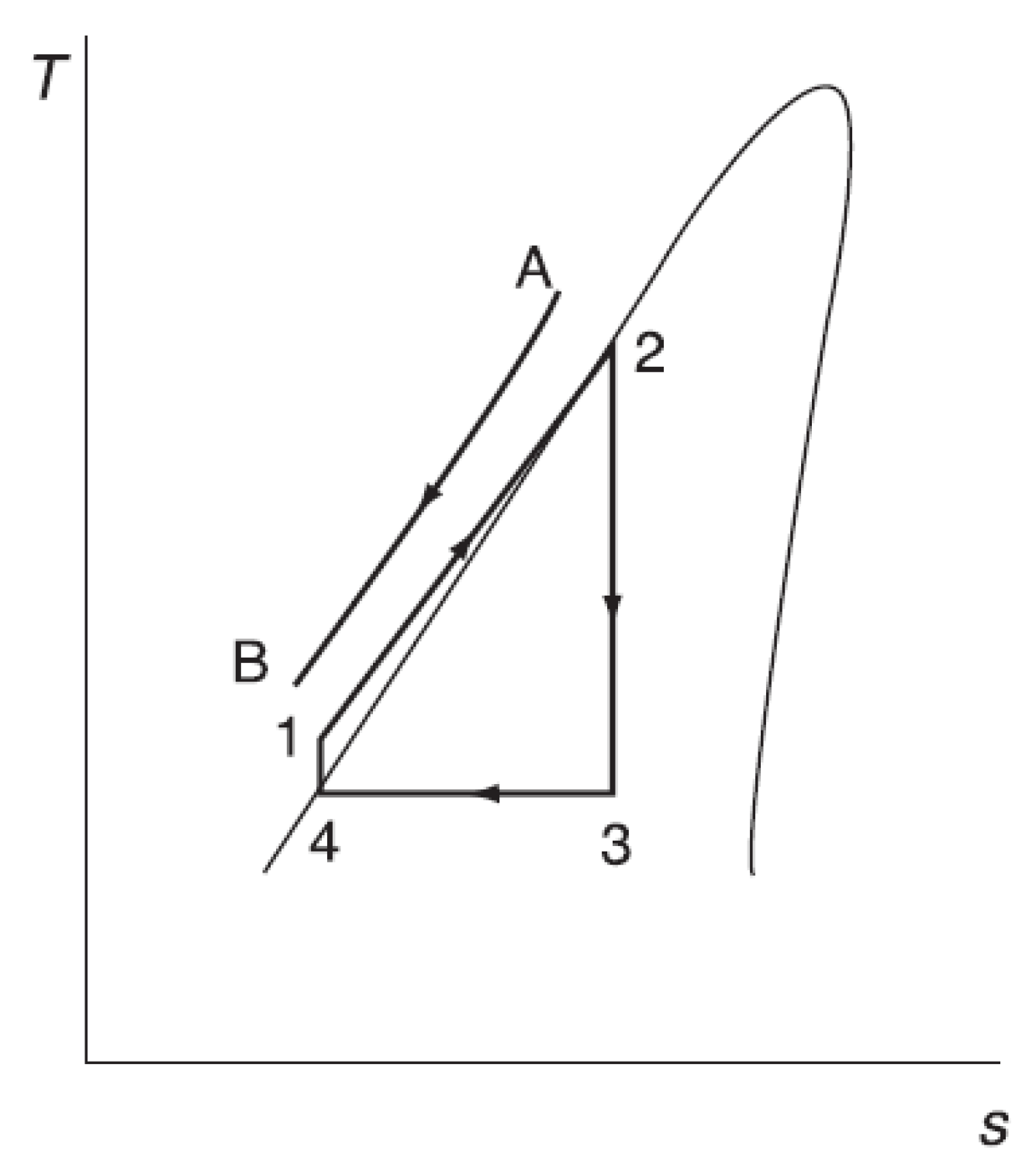
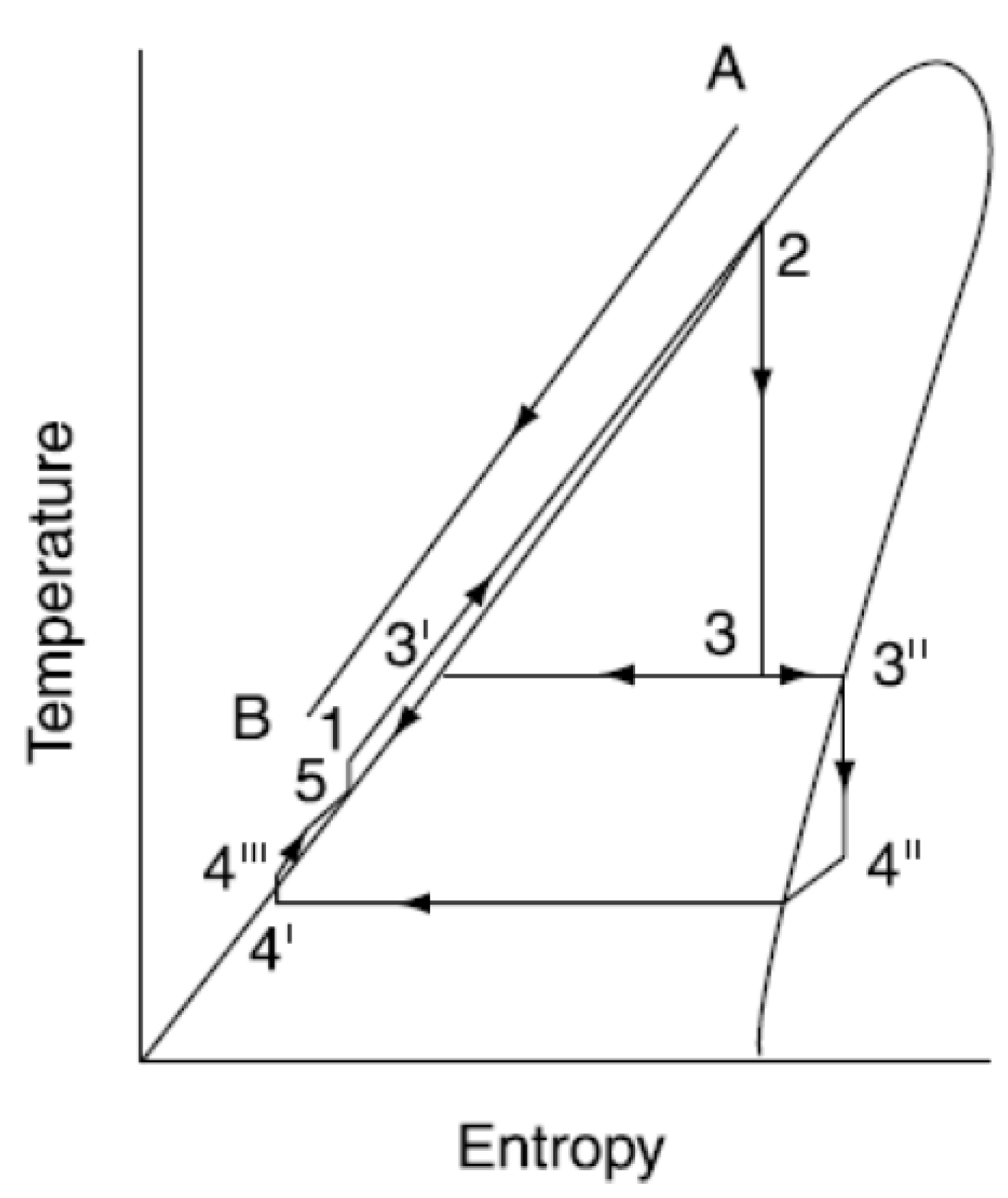
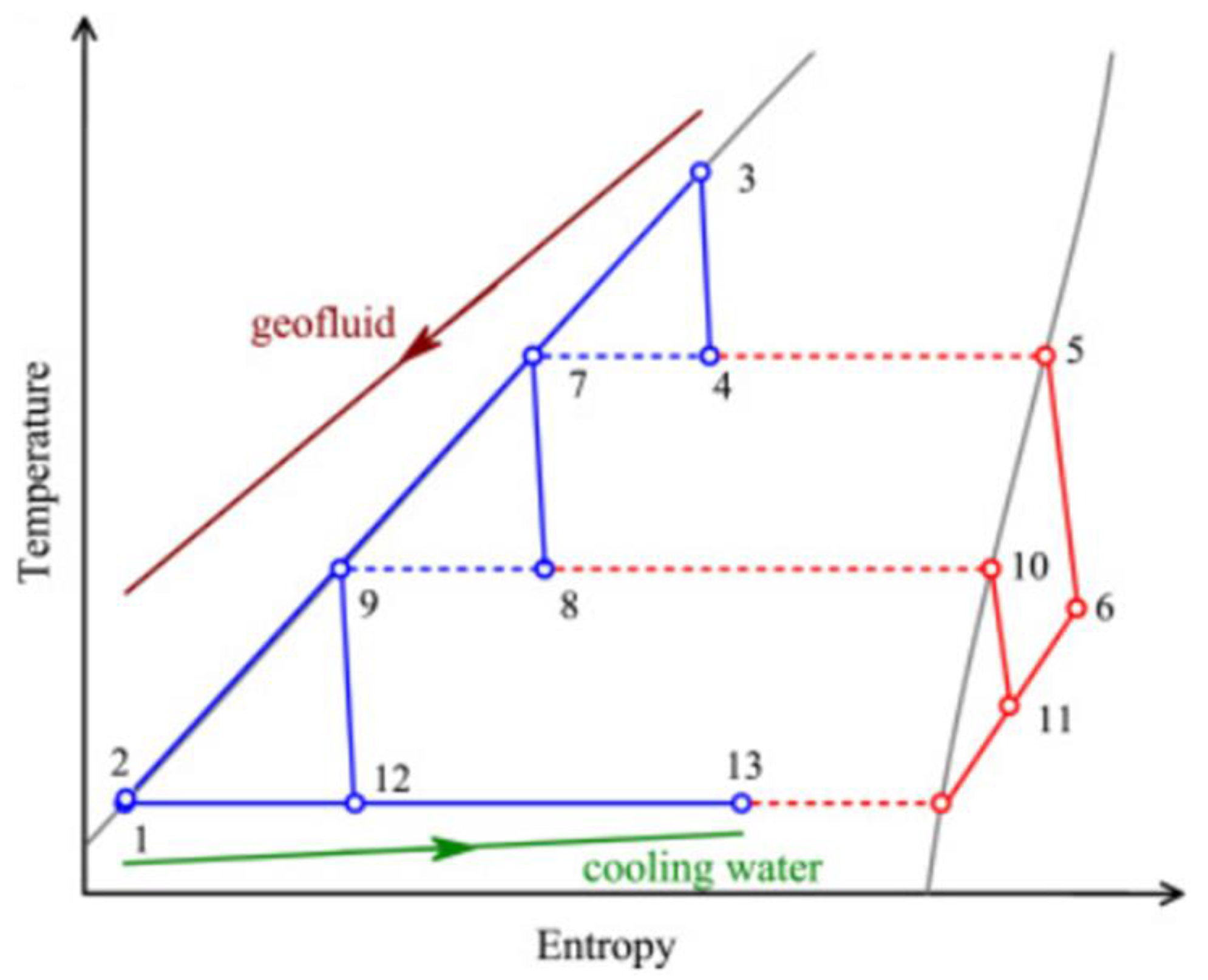
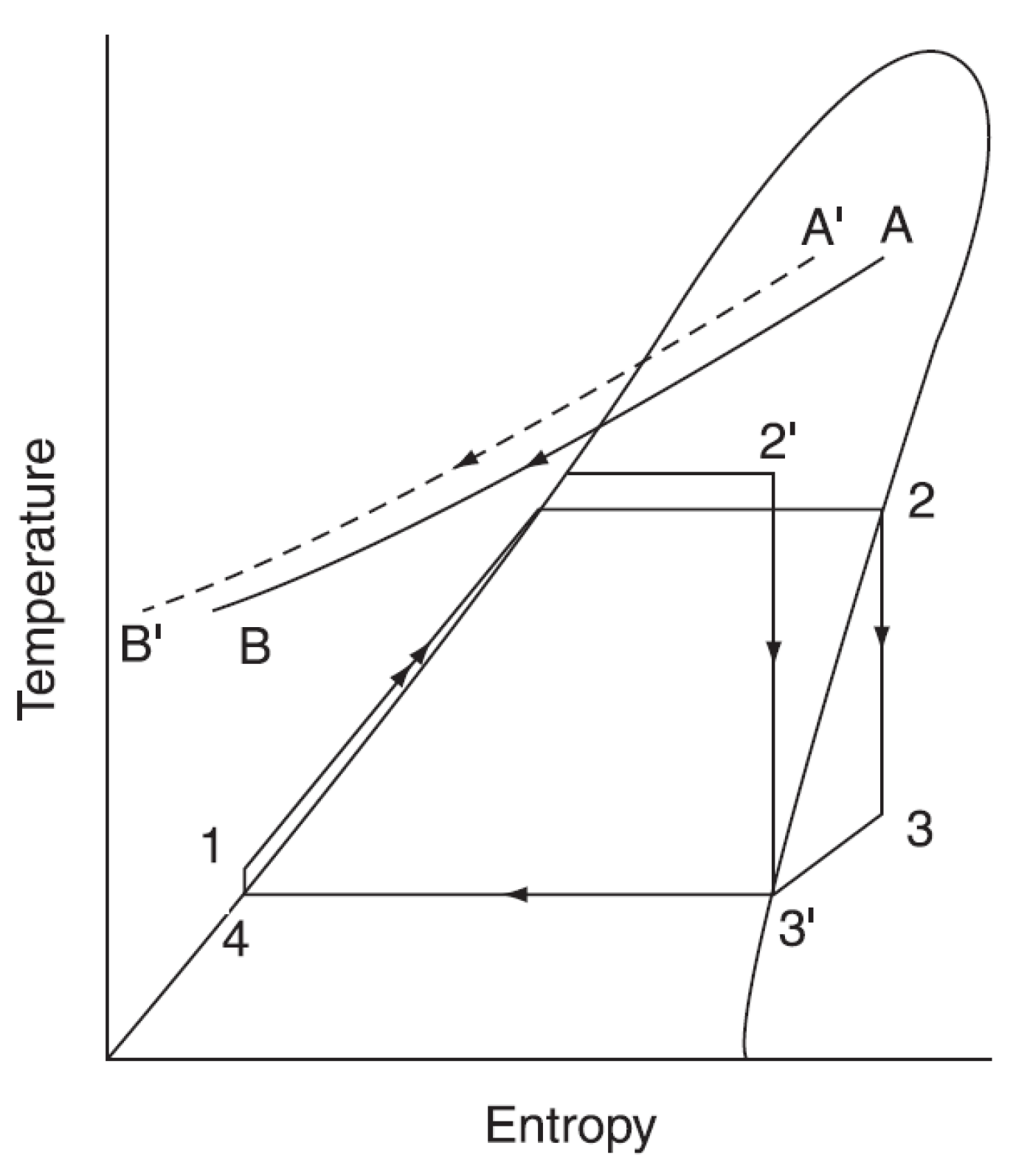

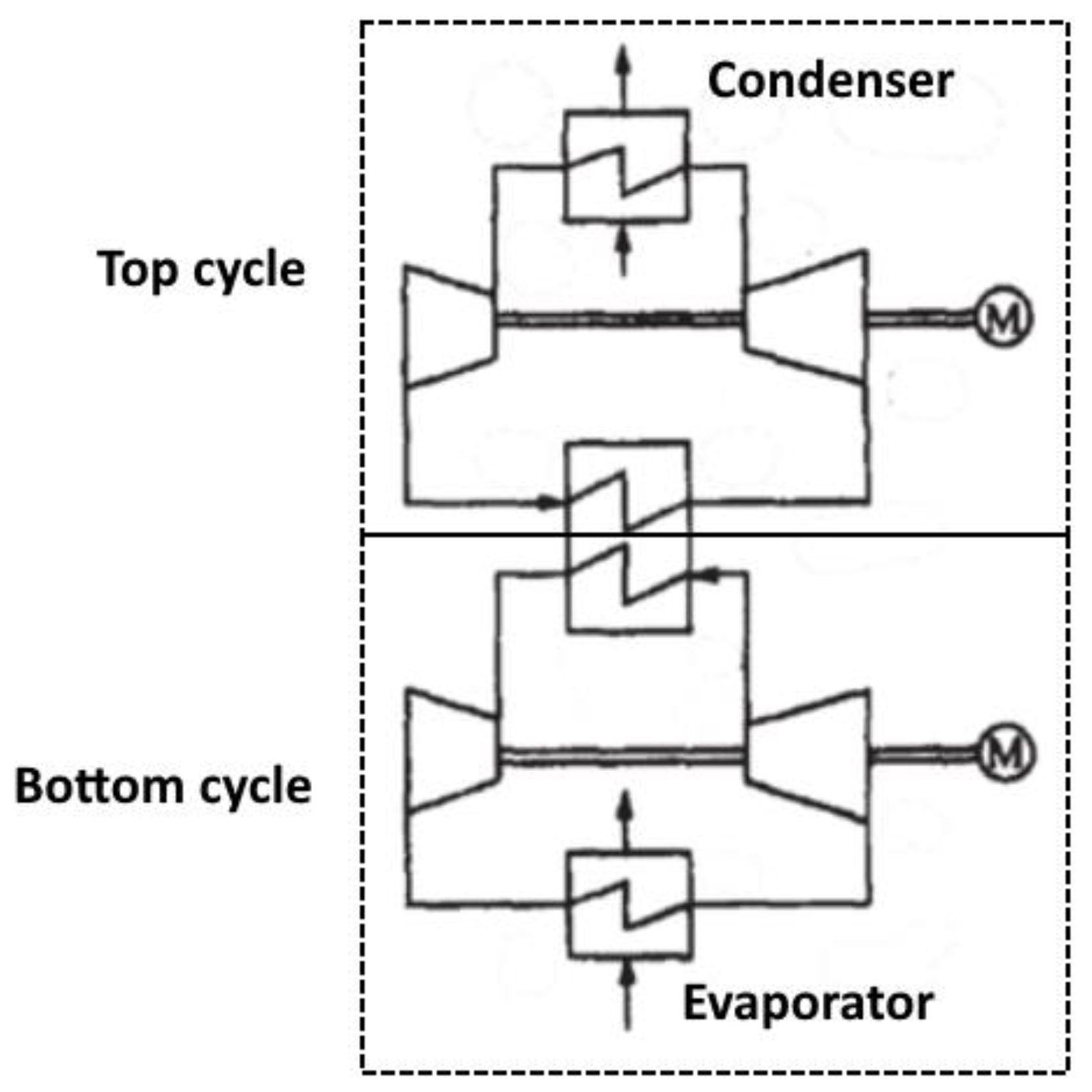
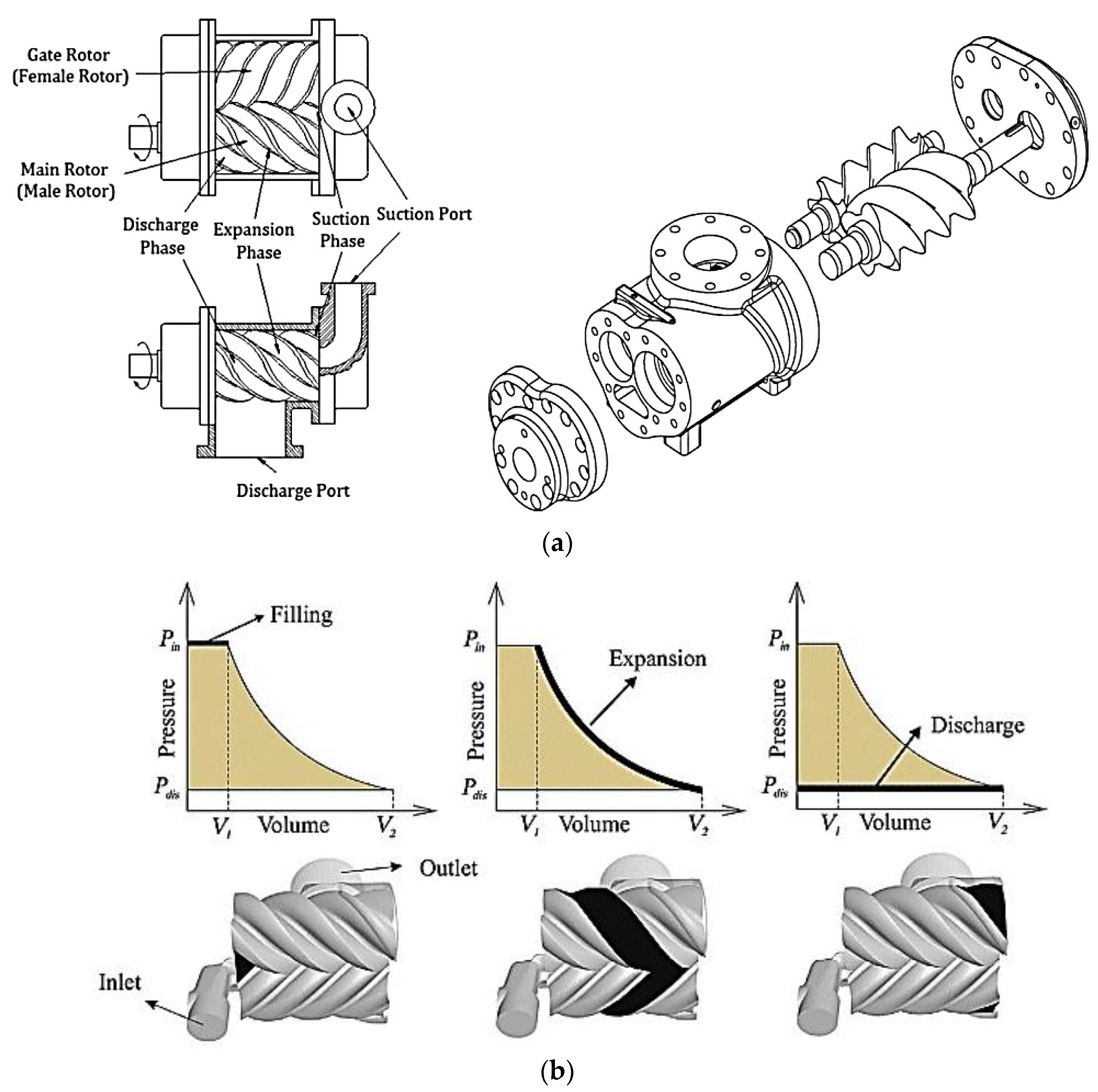
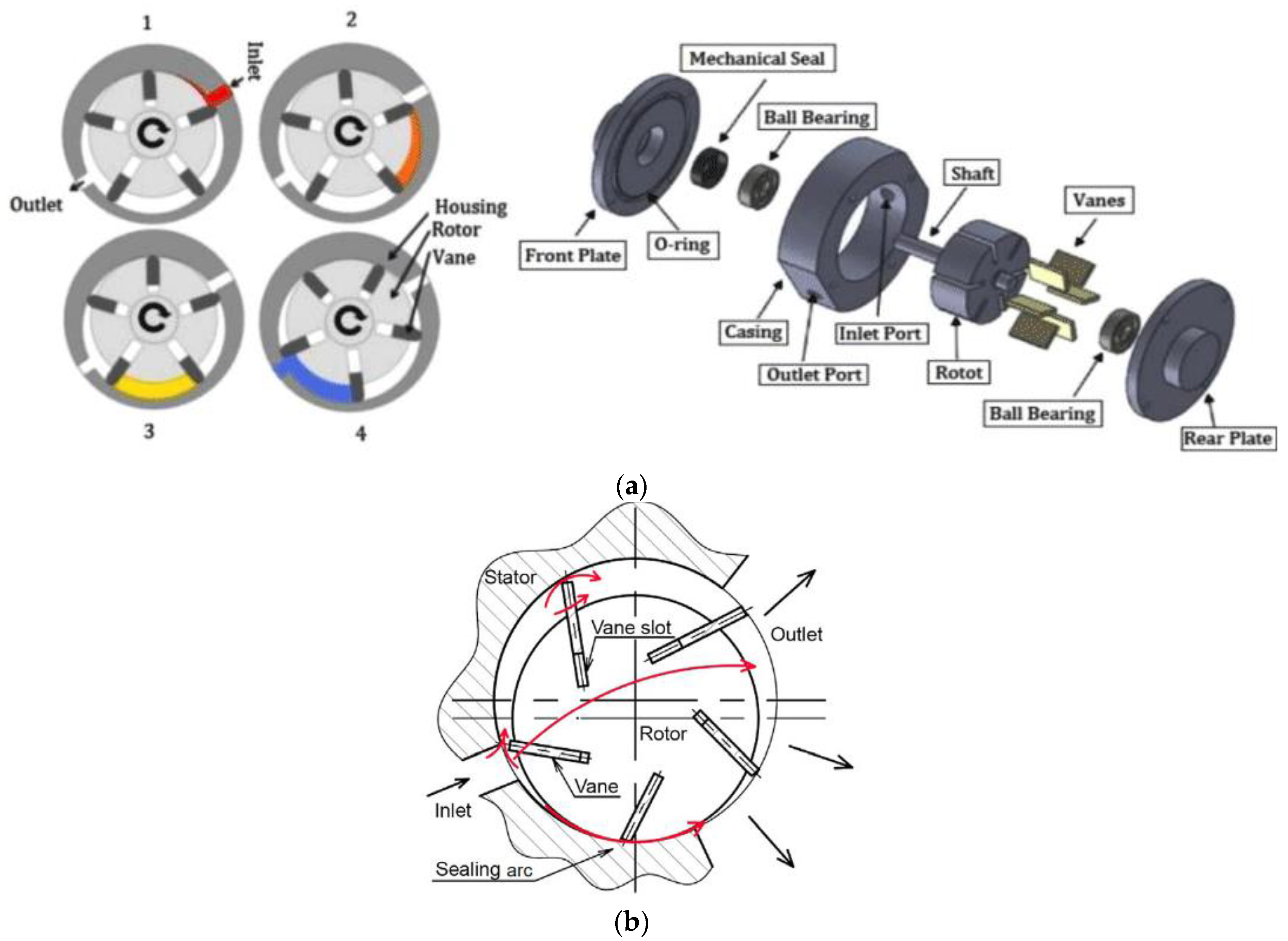
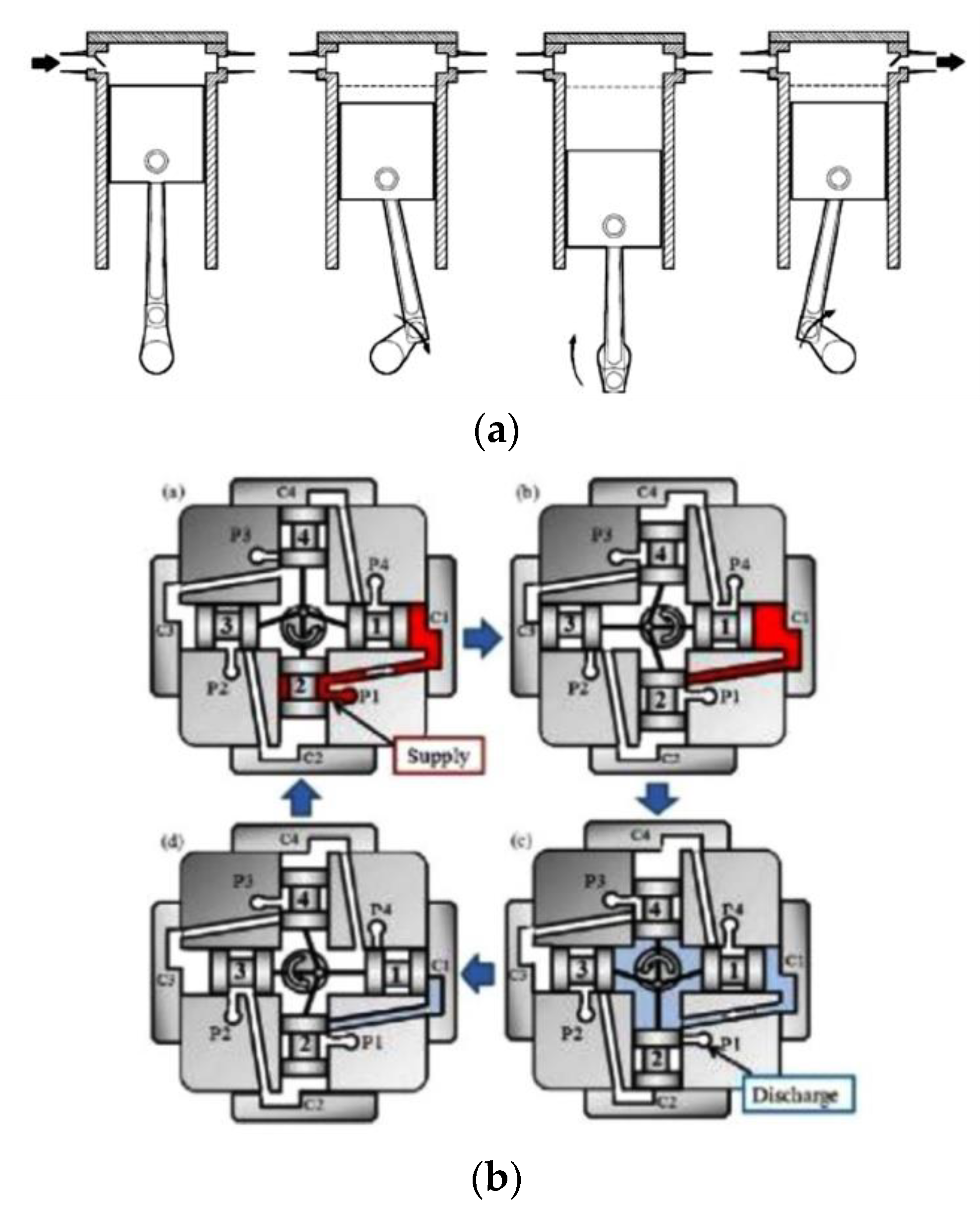

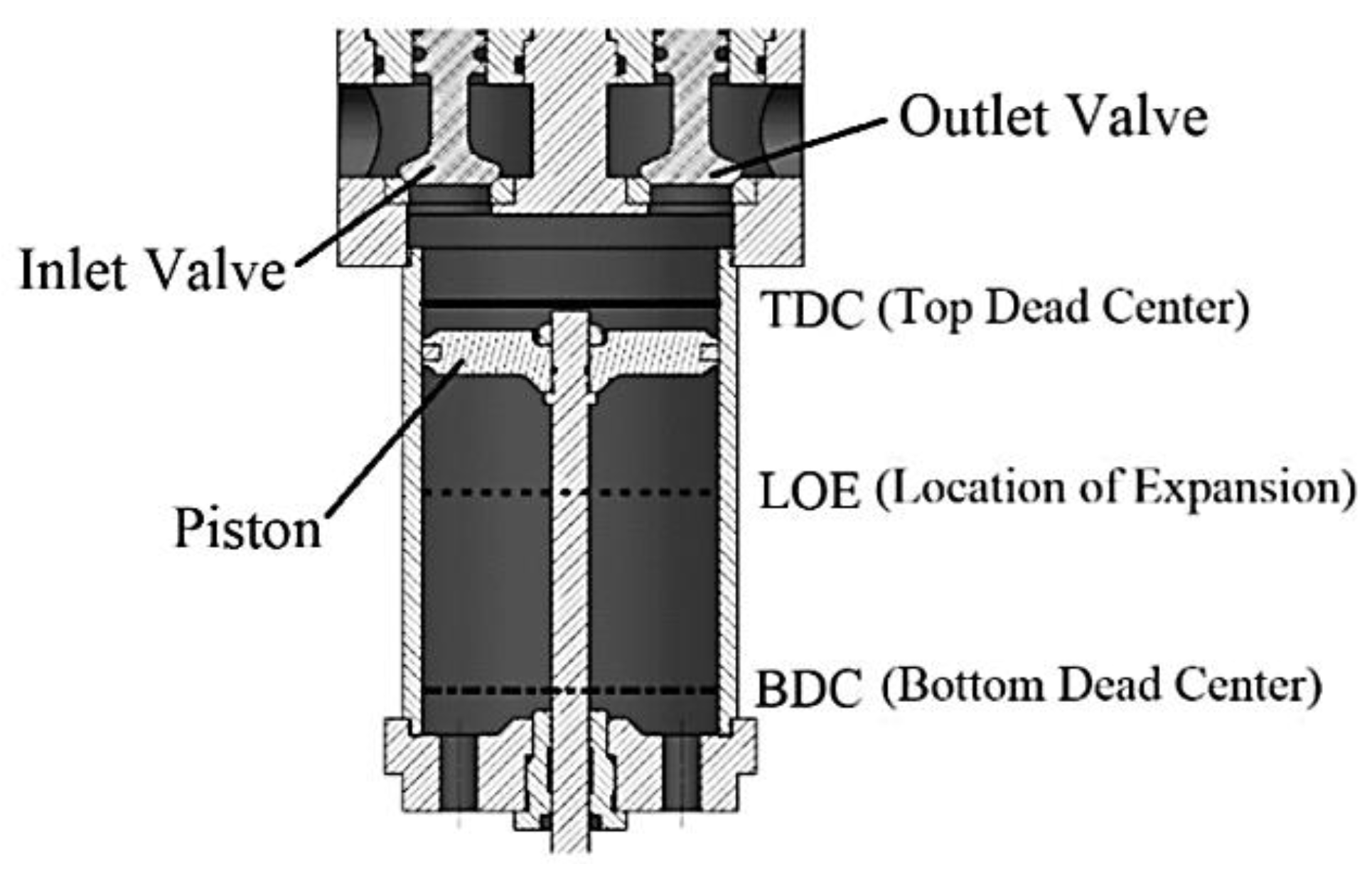

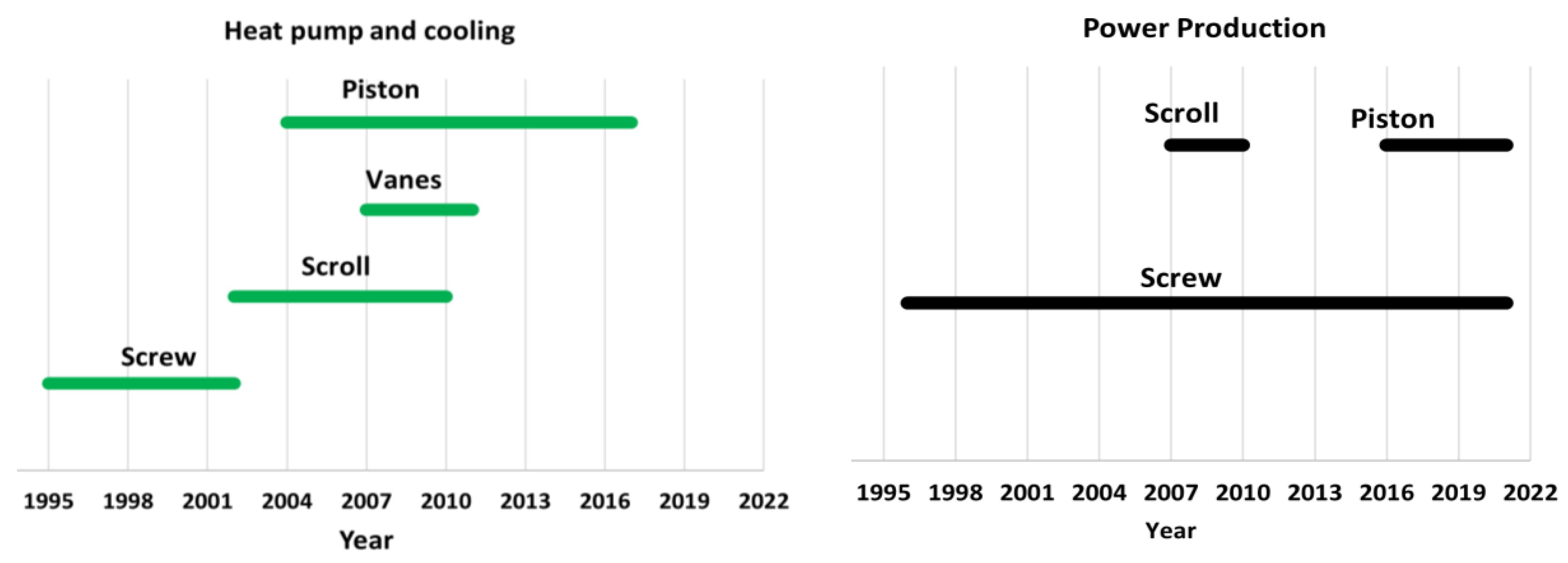
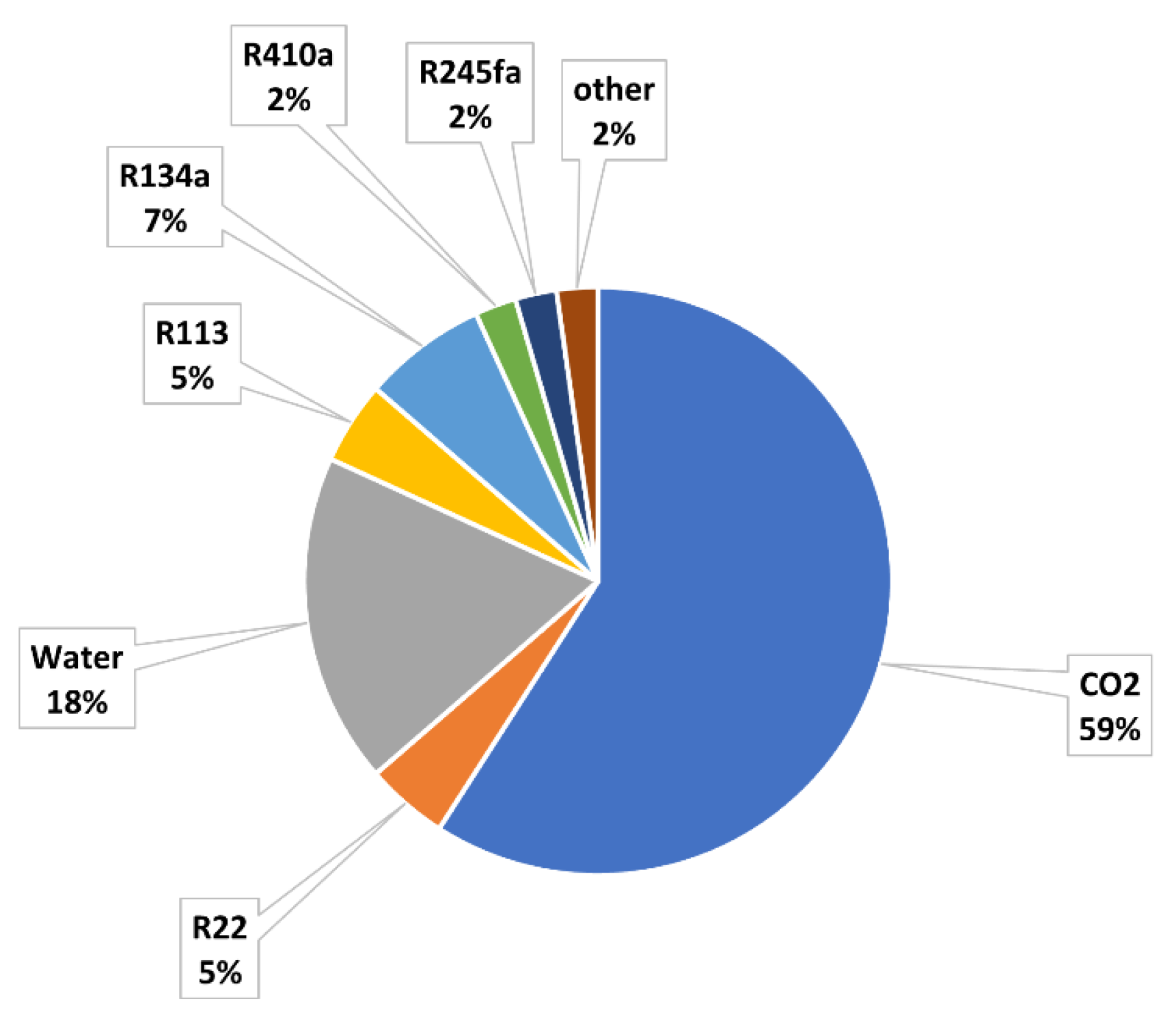
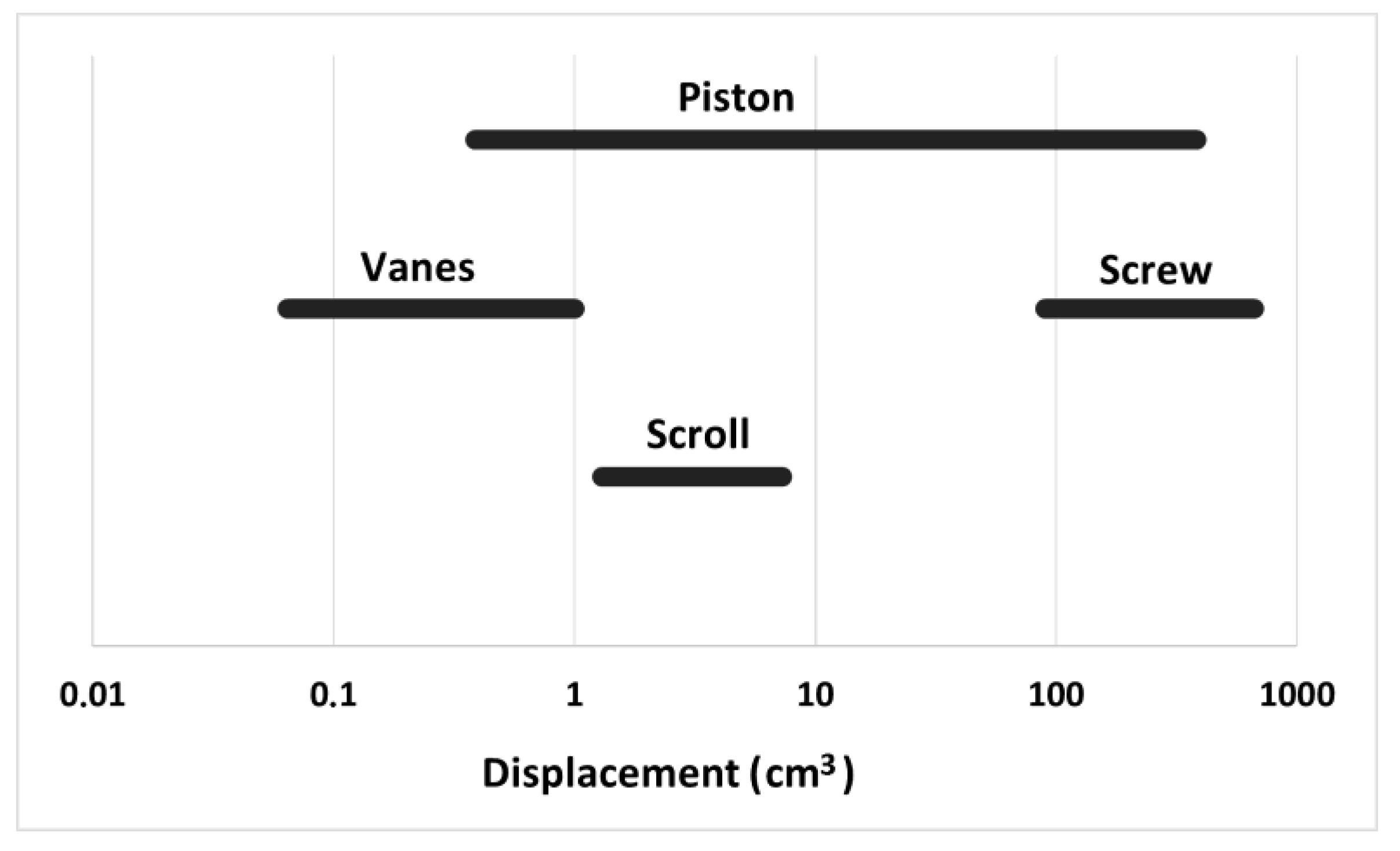

| Article, Year | Study | Use | Fluid | V [cm3] | BVR [-] | pin [MPa] | Tin [°C] | pout [MPa] | N [rpm] | [kg/h] | P [W] | ηis [-] | ηm [-] | ηov [-] | ηvol [-] |
|---|---|---|---|---|---|---|---|---|---|---|---|---|---|---|---|
| [33] 2006 | Nc, E | HP | CO2 | 3.35 | 2.18 | 9 | 40 | 4 | 2000–4000 | 0.30–0.60 | 0.80 | ||||
| [35] 2008 | E | HP | CO2 | 2.8 | 2.0 | 8.2 | 36 | 3.96–4.77 | 2200–3400 | 130–225 | 0.70 | 0.70–0.90 | |||
| [36] 2003 | Nc | HP | R22, CO2 | 7.3 | 2.42 | 8.56 | 4.17 | 1500–3300 | 0.73–0.36 | 0.50–0.88 | |||||
| [37] 2002 | Nc | HP | |||||||||||||
| [38] 2004 | Nc | HP | CO2 | 1.8 | 2.5 | 131 | 57.2 | 3500 | 340 | 0.60 | |||||
| [39] 2004 | E | HP | CO2 | 2.3 | 2 | 124 | 4.1 | 3300 | 182 | 0.637 | |||||
| [40] 2008 | E | HP | CO2 | 2500–3000 | |||||||||||
| [41] 2007 | Nc | HP | CO2 | 1.32 | 2.91 | 8.5–11 | 20–40 | 3.0–4.5 | 3500 | 0.063 | 0.440 | 0.861 | 0.600–0.650 | 0.544 | 0.850–0.900 |
| [42] 2010 | E | HP | CO2 | 1800–3600 | 280–510 | 0.97–1.54 | |||||||||
| [43] 2007 | Nc, E | PP | Water | 1.20–1.30 | 139–145 | 0.11 | 1000–1400 | 300 | 10–12 E 12–15 N | 0.34 | 0.42–0.52 | ||||
| [44] 2010 | E | CHP | Water | 2800–3600 | 1.9–2.5 |
| Article, Year | Study | Use | Fluid | V [cm3] | BVR [-] | pin [MPa] | Tin [°C] | pout [MPa] | N [rpm] | [kg/s] | P [kW] | ηis [-] | ηad [-] | ηvol [-] |
|---|---|---|---|---|---|---|---|---|---|---|---|---|---|---|
| [47] 1973 | Pt | PP | Water | |||||||||||
| [48] 1996 | Nc, E | PP | R113 n butane | 3–6 | 90–120 | 3600–4800 | 10–50 | 0.20–0.80 | ||||||
| [49] 2005 | Nc | PP | R134a n butane | 3000 | 879–2300 | 0.75–0.80 | ||||||||
| [50] 2007 | E | PP | R124 | 22 | 0.74 | |||||||||
| [51] 2014 | Nc, E | PP | Water | 4500 | 0.2–1.1 | 70–140 | 0.30–0.75 | |||||||
| [52] 2016 | Nc | PP | 664 | 4.1 | 0.68–1.10 | 160–180 | 0.8–1.4 | 0.10–0.70 | ||||||
| [53] 2018 | E | PP | Water | 90 | 2.5 | 0.3–0.5 | 60 | 0.1 | 18,000 | 0.02–0.12 | ||||
| [54] 2020 | Nc | PP | R245fa | 2.63–5.06 | 0.64 | 0.11 | 3000–6000 | 24.8 | 54.2–92.7 | 0.63–0.82 | 0.53–0.77 | |||
| [55] 1997 | Nc | HP | NH3 Steam | |||||||||||
| [56] 1999 | E | HP | R113 | 2.85 | 0.845 | 126 | 0.37 | 1500–3800 | 6–15 | 0.50–0.76 | ||||
| [57] 1995 | Nc | HP | R134a | 4200 | 75 | |||||||||
| [58] 2000 | E | HP | R113 | 1.85–1.85 | 1500–3000 | 1–1.5 | 10–20 | 0.70 | ||||||
| [59] 2002 | HP | CO2 | 10 | 40 | 3.48 |
| Article, Year | Study | Use | Fluid | V [cm3] | BVR [-] | pin [MPa] | Tin [°C] | pout [MPa] | N [rpm] | [kg/h] | P [kW] | ηis [-] | ηm [-] | ηov [-] | ηvol [-] |
|---|---|---|---|---|---|---|---|---|---|---|---|---|---|---|---|
| [60] 2009 | E | HP | CO2 | 7.85–8.35 | 4.51–4.94 | 800–1800 | 658–673 | 0.348–0.379 | 0.19–0.23 | 0.17–0.30 | |||||
| [61] 2008 | Nc, E | HP | 2.1 | 500–3000 | 0.10–0.60 | ||||||||||
| [62] 2009 | E | HP | CO2 | 7.5–9.0 | 32.4–44.3 | 4.8–6.4 | 400–1400 | 0.17–0.28 | 0.17–0.30 | ||||||
| [63] 2009 | E | HP | CO2 | ||||||||||||
| [64] 2008 | E | HP | CO2 | 0.064 | 2.0 | 9.1 | 35–45 | 4.1 | 1000–2500 | 0.8–0.9 | 0.5 | 0.6–0.7 | |||
| [65] 2011 | E | HP | CO2 | 7.91–8.98 | 34–42 | 3.78–4.08 | 800–1900 | 660.5–719.0 | 0.78–0.98 | 0.15–0.45 | 0.22–0.35 | ||||
| [66] 2007 | Nc | HP | CO2 | 1–3 | 1.729 | 0.584 | 0.85 | ||||||||
| [67] 2009 | E | HP | R22 R134a | 5.0–7.5 | |||||||||||
| [68] 2010 | Nc | HP | R410a | 3.39 | 54.4 | 1.0 | 800–3000 | 331.2 | 0.4–0.6 | 0.36–0.62 | 0.47–0.88 | 0.37–0.76 | |||
| [69] 2011 | Nc | HP | CO2 | 1.69 | 9.0 | 35 | 4.5 | 3000 | 0.138–0.312 | 0.198–0.427 | 0.487–0.775 |
| Type | Tolerance to Wet Expansion | Pin | Tin | N | P | ηis | ηad | ηm | ηov | ηvol | Mechanical Complexity | |
|---|---|---|---|---|---|---|---|---|---|---|---|---|
| [bar] | [°C] | [rpm] | [kg/s] | [kW] | [-] | [-] | [-] | [-] | [-] | |||
| Scroll | Medium | 8–131 | 20–145 | 1000–4000 | 1.8 × 10−5–0.14 | 0.4–12 | 0.70–0.80 | 0.60–0.65 | 0.30–0.60 | 0.42–0.80 | Medium | |
| Screw | High | 3–100 | 40–180 | 1500–4800 | 0.02–24.80 | 6–2300 | 0.10–0.70 | 0.20–0.80 | 0.27–0.56 | 0.53–0.77 | Medium–high | |
| Vanes | Medium | 21–91 | 32–54 | 500–3000 | 0.092–0.200 | 0.138–0.980 | 0.15–0.62 | 0.47–0.90 | 0.20–0.50 | 0.22–0.78 | Medium | |
| Piston | Medium–low | 12–100 | 33–120 | 500–3000 | 0.001–3 | 0.1–0.8 | 0.20–0.70 | 0.50–0.90 | 0.10–0.60 | 0.50–0.80 | Low–high |
Publisher’s Note: MDPI stays neutral with regard to jurisdictional claims in published maps and institutional affiliations. |
© 2022 by the authors. Licensee MDPI, Basel, Switzerland. This article is an open access article distributed under the terms and conditions of the Creative Commons Attribution (CC BY) license (https://creativecommons.org/licenses/by/4.0/).
Share and Cite
Francesconi, M.; Briola, S.; Antonelli, M. A Review on Two-Phase Volumetric Expanders and Their Applications. Appl. Sci. 2022, 12, 10328. https://doi.org/10.3390/app122010328
Francesconi M, Briola S, Antonelli M. A Review on Two-Phase Volumetric Expanders and Their Applications. Applied Sciences. 2022; 12(20):10328. https://doi.org/10.3390/app122010328
Chicago/Turabian StyleFrancesconi, Marco, Stefano Briola, and Marco Antonelli. 2022. "A Review on Two-Phase Volumetric Expanders and Their Applications" Applied Sciences 12, no. 20: 10328. https://doi.org/10.3390/app122010328
APA StyleFrancesconi, M., Briola, S., & Antonelli, M. (2022). A Review on Two-Phase Volumetric Expanders and Their Applications. Applied Sciences, 12(20), 10328. https://doi.org/10.3390/app122010328









